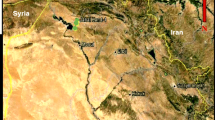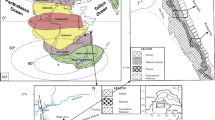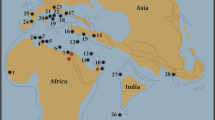Abstract
The frontal part of the active, wedge-shaped Indo-Eurasian collision boundary is defined by the Himalayan fold-and-thrust belt whose foreland basin accumulated sediments that eventually became part of the thrust belt and is presently exposed as the sedimentary rocks of the Siwalik Group. The rocks of the Siwalik Group have been extensively studied in the western and Nepal Himalaya and have been divided into the Lower, Middle and Upper Subgroups. In the Darjiling–Sikkim Himalaya, the Upper Siwalik sequence is not exposed and the Middle Siwalik Subgroup exposed in the Tista river valley of Darjiling Himalaya preserves a ~325 m thick sequence of sandstone, conglomerate and shale. The Middle Siwalik section has been repeated by a number of north dipping thrusts. The sedimentary facies and facies associations within the lithostratigraphic column of the Middle Siwalik rocks show temporal repetition of sedimentary facies associations suggesting oscillation between proximal-, mid- and distal fan setups within a palaeo-alluvial fan depositional environment similar to the depositional setup of the Siwalik sediments in other parts of the Himalaya. These oscillations are probably due to a combination of foreland-ward movement of Himalayan thrusts, climatic variations and mountain-ward shift of fan-apex due to erosion. The Middle Siwalik sediments were derived from Higher- and Lesser Himalayan rocks. Mineral characteristics and modal analysis suggest that sedimentation occurred in humid climatic conditions similar to the moist humid climate of the present day Eastern Himalaya.
Similar content being viewed by others
References
Acharyya S K 1976 On the nature of the Main Boundary Fault in the Darjiling sub-Himalaya; Geol. Surv. India Misc. Publ. 24 395–408.
Acharyya S K 1994 The Cenozoic Foreland Basin and tectonics of the eastern sub-Himalaya: Problems and prospects; In: Siwalik Foreland Basin of Himalaya (eds) Kumar R, Ghosh S K and Phadtare N R, Him. Geol. 15 3 21.
Arribas J and Tortosa A 2003 Detrital modes in sedimentoclastic sands from first-order streams of the Iberian Range, Spain: The potential for sand generation of different sedimentary rocks; Sedim. Geol. 15 275–303.
Banerjee A and Banerjee D M 2010 Modal analysis and geochemistry of two sandstones of the Bhander Group (Late Neoproterozoic) in parts of the Central Indian Vindhyan basin and their bearing on the provenance and tectonics; J. Earth Syst. Sci. 119(6) 825–839.
Banerji I and Banerji S 1982 A coalescing alluvial fan model of the Siwalik sedimentation – a case study in the eastern Himalaya; Geol. Surv. India Misc. Publ. 41 1–12.
Basak K and Mukul M 2000 Deformation mechanisms in the South Kalijhora Thrust and thrust sheet in the Darjiling Himalayan fold-and-thrust belt, West Bengal, India; Indian J. Geol. 72(2) 143–152.
Basu A 1976 Petrology of the Holocene fluvial sand derived from plutonic source rocks: Implications to palaeoclimatic interpretations; J. Sedim. Petrol. 46 694–709.
Basu A, Young S W, Suttner L J, James W C and Mark G H 1975 Re-evaluation of the use of undulatory extinction and polycrystallinity in detrital quartz for provenance interpretation; J. Sedim. Petrol. 45 873–882.
Bhattacharyya K and Mitra G 2009 A new kinematic evolutionary model for the growth of a duplex – an example from the Rangit duplex, Sikkim Himalaya, India; Gondwana Res. 16 697–715.
Blair T C and Mcpherson J G 1994 Alluvial fans – processes and forms; In: Geomorphology of desert environments (eds) Abrahams A D and Parsons A J (London: Chapman & Hall), pp. 354–402.
Blenkinsop T 2002 Deformation microstructures and mechanismsin in minerals and rocks (Dordrecht: Kluwer Academic Publishers), p. 150.
Brozovic N and Burbank D W 2000 Dynamic fluvial systems and gravel progradation in the Himalayan foreland; Geol. Soc. Am. Bull. 112(3) 394–412.
Cadle A B and Cairncross B 1993 A sandy, bed-load dominated fluvial system deposited by lateral-accretion: Permian Karoo Sequence, South Africa; Sedim. Geol. 85(1–4) 435–455.
Cant D J 1978 Bedforms and bar types in the South Saskatchewan River; Geol. Soc. Am. Bull. 94 117–133.
Casshyap S M and Tewari 1984 Fluvial models of the Lower Permian coal measures of Son–Mahanadi and Koel–Damodar Valley basins, India; Int. Assoc. Sedimentologists Spec. Publ. 7 121–147.
Chaudhuri A 1977 Influence of eolian processes on Precambrian sandstones of the Godavari valley, South India; Precamb. Res. 4 339–360.
Critelli S and Ingersoll R V 1994 Sandstone petrology and provenance of the Siwauk Group (northwestern Pakistan and western–southeastern Nepal); J. Sedim. Res. A 64(4) 815–823.
Datta B 2005 Provenance, tectonics and palaeoclimate of Proterozoic Chandarpur sandstones, Chattisgarh basin: A petrographic view; J. Earth Syst. Sci. 114(3) 212–226.
DeCelles P G, Gehrels G E, Quade J, Ojha T P, Kapp P A and Upreti B N 1998 Neogene foreland basin deposits, erosional unroofing, and the kinematic history of the Himalayan fold and thrust belt, western Nepal; Geol. Soc. Am. Bull. 110 2–21.
Demicco R V and Gierlowski Kordesch E 1986 Facies sequences of a semi-arid closed basin: The lower Jurassic East Berlin Formation of the Hartford Basin, New England, USA; Sedimentology 33 107–118.
Dickinson W R 1985 Interpreting provenance relations from detrital modes of sandstones; In: Provenance of Arenites (ed.) Zuffa G G, NATO-ASI. V.C.-148 (Dordrecht: D. Reidel Publ. Co.), pp. 333–361.
Dickinson W R, Beard S L, Brakenridge R G, Erjavec J L, Ferguson R C, Inman K F, Knepp R A, Lindberg F A and Ryherg P T 1983 Provenance of North American Phanerozoic Sandstones in relation to tectonic setting; Geol. Soc. Am. Bull. 94 222–235.
Dreyer T 1993 Quantified fluvial architecture in ephemeral stream deposits of the Esplugafreda Fm. (Paleocene), Tremp–Graus Basin, N Spain; Int. Assoc. Sedimentologists Spec. Publ. 17 337–362.
Fraser J Z 1982 Derivation of a summary facies sequence based on Markov chain analysis of the Caledon outwash: A Pleistocene raided glacial fluvial deposit; In: Research in glacial, glacio-fluvial and glacio-lacustrine systems (ed.) Davidson–Arnott R, Proceedings of VI Guelph Symposium on Geomorphology (1980), (Norwich: Geo Books), pp. 175–202.
Friend P F, Alexander–Marrack P D, Nicholson J and Yeats A K 1976 Devonian sediments of the east Greenland II: Sedimentary structures and fossils; Medd. Gr. 206(2) 1–91.
Ganguly S and Rao D P 1970 Stratigraphy and structure of Tertiary foothills of the Eastern Himalaya, Darjiling Dist. West Bengal; Quart. J. Geol. Min. Metall. Soc. India 42 185–195.
Gansser A 1964 Geology of the Himalayas (New York: Wiley), p. 289.
Garzanti E, Critelli S and Ingersoll R V 1996 Paleogeographic and paleotectonic evolution of the Himalayan range as reflected by detrital modes of Tertiary sandstones and modern sands (Indus transect, India and Pakistan); Geol. Soc. Am. Bull. 86 273–286.
Gordon E A and Bridge J S 1987 Evolution of Catskill (Upper Devonian) river systems: Intra- and extrabasinal controls; J. Sedim. Petrol. 57 234–249.
Gupta A K, Ahmad S M, Dayal A M and Gopalan K 2000 Is strontium isotope record a strict proxy for chemical weathering rates during the late Miocene (Ocean Drilling Program Site 758A); Curr. Sci. 79(6) 899–902.
Hartley A J 1993 Sedimentological response of an alluvial system to source area tectonism: The Seilao Member of the Late Cretaceous to Eocene Purilactis Fm. of N Chile; Int. Assoc. Sedimentologist Spec. Publ. 17 489–500.
Heim A and Gansser A 1939 Central Himalayas – Geological observations of Swiss expeditions, 1936; Mem. Soc. Helv. Sci. Natur. 73 1–246.
Heward A P 1978 Alluvial fan and lacustrine sediments from the Stephanian A and B (La Magdalena, Ciñera–Matallana and Sabero) coalfields, N Spain; Sedimentology 25 451–488.
Hodges K V 2000 Tectonics of the Himalaya and southern Tibet from two perspectives; Geol. Soc. Am. Bull. 112 324–350.
Kimura K 1999 Diachronous evolution of sub-Himalayan piggyback basins, Nepal; Isl. Arc 8(1) 99–113.
Kumar G 1997 Geology of Arunachal Pradesh (Bangalore: Geological Society of India), p. 217.
Kumar R and Tandon S K 1985 Sedimentology of Plio–Pleistocene late orogenic deposits associated with intra-plate subduction – The Upper Siwalik Sub group of a part of Punjab sub-Himalaya, India; Sedim. Geol. 42 105–158.
Kumar R, Ghosh S K and Sangode S J 2003 Mio–Pliocene sedimentation history in the northwestern part of the Himalayan foreland basin, India; Curr. Sci. 84(8) 1006–1113.
Kumar R, Sangode S J and Ghosh S K 2004 A multistorey sandstone complex in the Himalayan foreland basin, NW Himalaya, India; J. Asian Earth Sci. 23 407–426.
Kundu A and Matin A 2007 Sedimentary and tectonic environment of deposition of the Archaean Birtola Formation; Indian J. Geol. 79(1–4) 22–34.
Kundu A, Matin A, Mukul M and Eriksson P G 2011 Sedimentary facies and soft-sediment deformation structures in the Late Miocene–Pliocene Middle Siwalik Subgroup, Eastern Himalaya, Darjiling District, India; J. Geol. Soc. India 78(4) 321–336.
MacCarthy I A J 1990 Alluvial sedimentation patterns in the Munster Basin, Ireland; Sedimentology 37 685–712.
Maizels J 1993 Lithofacies variations within sandur deposits: The role of runoff regime, flow dynamics and sediment supply characteristics; Sedim. Geol. 85 299–325.
Marshak S and Mitra G 1988 Basic Methods of Structural Geology; Englewood Cliffs (New Jersey: Prentice-Hall), p. 449.
Matin A and Mukul M 2010 Phases of deformation from cross-cutting structural relationships in external thrust sheets: Insights from small-scale structures in the Ramgarh thrust sheet, Darjiling Himalaya, West Bengal; Curr. Sci. 99 1369–1377.
Mazumder R 2002 Sedimentation history of the Dhanjori and Chaibasa formations, eastern India and its implications; Unpublished Ph.D. thesis (Kolkata, India: Jadavpur University), p. 119.
Medlicott H B 1864 On the geological structure and relations of the southern portion of the Himalayan ranges between the rivers Ganges and the Ravee; Geol. Surv. India Memoir 3(2) 1–212.
Miall A D 1977 A review of the braided-river depositional environment; Earth-Sci. Rev. 13 1–62.
Miall A D 1992 Alluvial deposits; In: Facies models: Response to sea level change (eds) Walker R G and James N P, Geological Associety Canada, pp. 119–142.
Miall AD 1996 The geology of fluvial deposits: Sedimentary facies, basin analysis, and petroleum geology (Berlin: Springer-Verlag), p. 582.
Mishra B, Pandya K L and Maejima W 2004 Alluvial Fan-lacustrine sedimentation and its tectonic implications in the Cretaceous Athgarh Gondwana Basin, Orissa, India; Gondwana Res. 7(2) 375–385.
Mukul M 2000 The geometry and kinematics of the Main Boundary Thrust and related neotectonics in the Darjiling Himalayan fold-and-thrust belt, West Bengal, India; J. Struct. Geol. 22 1261–1283.
Mukul M 2010 First-order kinematics of wedge-scale active Himalayan deformation: Insights from Darjiling–Sikkim–Tibet (DaSiT) wedge; J. Asian Earth Sci. 39 645–657.
Najman Y 2006 The detrital record of orogenesis: A review of approaches and techniques used in the Himalayan sedimentary basins; Earth-Sci. Rev. 74 1–72.
Najman Y and Garzanti E 2000 Reconstructing early Himalayan tectonic evolution and paleogeography from Tertiary foreland basin sedimentary rocks, northern India; Geol. Soc. Am. Bull. 112 435–449.
Nakata T 1972 Geomorphic history and crustal movements of the Himalaya (Aendai: Institute of Geography, Tohuku University), p. 77.
Nakayama K and Ulak P D 1999 Evolution of fluvial style in the Siwalik Group in the foothills of the Nepal Himalaya; Sedim. Geol. 125 205–224.
Nemec W and Postma G 1993 Quaternary alluvial fans in southern Crete: Sedimentation process and geomorphic evolution; In: Alluvial sedimentation (eds) Marzo M and Puigdefabregas C, Int. Assoc. Sedimentologists Spec. Publ. 17 235–276.
Neves M A, Morales N and Saad A R 2005 Facies analysis of tertiary alluvial fan deposits in the Jundiaí region, São Paulo, southeastern Brazil; J. S. Am. Earth. Sci. 19 513–524.
Nichols G 2009 Sedimentology and stratigraphy, 2nd edn (West Sussex: Wiley-Blackwell), p. 419.
Nichols G J and Fisher J A 2007 Processes, facies and architecture of fluvial distributory system deposits; Sedim. Geol. 195 75–90.
Nilsen H 1982 Alluvial fan deposits; In: Sandstone depositional environments (eds) Scholle P A and Spearing D, Mem. Am. Assoc. Petrol. Geol. 31 49–86.
Opluštil S, Martínek K and Tasáryová Z 2005 Facies and architectural analysis of fluvial deposits of the Nýřany Member and the Týnec Formation (Westphalian D – Barruelian) in the Kladno–Rakovník and Pilsen basins; Bull. Geosci. 80(1) 45–66.
Pettijohn F J 1975 Sedimentary Rocks, 3rd edn (New York: Harper and Row), p. 718.
Pettijohn F J, Potter P E and Siever R 1972 Sand and sandstone (New York: Springer), p. 618.
Pilgrim G E 1906 Notes on the geology of a portion of Bhutan; Rec. Geol. Surv. India 34 22–30.
Pilgrim G E 1913 Correlation of the Siwalik with mammal horizon of Europe; Rec. Geol. Surv. India 43(4) 264–326.
Prasad K N 2001 An introduction to the mammalian fauna of the Siwalik System (Chennai: Prasad Publications), p. 295.
Raina V K 1976 The Rangit Tectonic Window – stratigraphy, structure & tectonic interpretation and its bearing on the regional stratigraphy; Geol. Surv. India Misc. Publ. 41 36–42.
Raiverman V 2002 Foreland sedimentation, In: Himalayan tectonic regime: A look at the orogenic process (Dehradun, India: Bishen Singh Mahendra Pal Singh), p. 378.
Ranjan N and Banerjee D M 2009 Central Himalayan crystallines as the primary source for the sandstone – shale suites of the Siwalik Group: New geochemical evidence; Gondwana Res. 16 687–696.
Reading H G and Levell B K 1996 Controls on the sedimentary record; In: Sedimentary ennvironments: Processes, facies and stratigraphy (ed.) Reading H G (Oxford: Blackwell Science), pp. 5–36.
Reineck H E and Singh I B 1980 Depositional sedimentary environments (Berlin: Springer), p. 549.
Rust B R 1972 Structure and process in a braided river; Sedimentology 18 221–246.
Rust B R 1975 Fabric and structure of glaciofluval gravels; In: Glaciofluvial and glaciolacustrine sedimentation (eds) Jopling A V and Mcdonald B C, Soc. Eco. Paleontol. Mineral. Spec. Publ. 23 238–248.
Sadler S P and Kelly S B 1993 Fluvial processes and cyclicity in terminal fan deposits: An example from the Late Devonian of southwest Ireland; Sedim. Geol. 85 375–386.
Scherer C M S and Lavina E L C 2006 Stratigraphic evolution of a fluvial–eolian succession: The example of the Upper Jurassic–Lower Cretaceous Guará and Botucatu formations, Paraná Basin, Southernmost Brazil; Gondwana Res. 9 475–484.
Selley R C 1985 Ancient Sedimentary Environments; 2nd edn (London: Chapman and Hall), p. 317.
Sengupta S 1994 Introduction to sedimentology (Calcutta, India: Oxford & IBH), p. 314.
Sharma M, Sharma S, Shukla U K and Singh I B 2002 Sandstone body achitecture and stratigraphic trends in the Middle Siwalik succession of the Jammu area, India; J. Asian Earth Sci. 20 817–828.
Suttner L J, Basu A and Mack G H 1981 Climate and the origin of quartz arenites; J. Sedim. Petrol. 51 1235–1246.
Tewari R C 1995 Braided fluvial depositional model of Late Triassic Gondwana (Mahadeva) rocks of Son valley, Central India, Tectonic and paleogeographic implications; J. Geol. Soc. India 45 65–74.
Ullah K, Arif M and Shah M T 2006 Petrography of sandstones from the Kamlial and Chinji Formations, southwestern Kohat Plateau, NW Pakistan: Implications for source lithology and palaeoclimate; J. Him. Earth Sci. 39 1–13.
Veiga G D and Spalletti L A 2007 The Upper Jurassic (Kimmeridgian) fluvial–aeolian systems of the southern Neuquén Basin, Argentina; Gondwana Res. 11 286–302.
White N M, Pringle M, Garzanti E, Bickle M, Najman, Y, Chapman H and Friend P 2002 Constraints on the exhumation and erosion of the High Himalayan Slab, NW India, from foreland basin deposits; Earth Planet. Sci. Lett. 195 29–44.
Wysocka A 2009 Sedimentary environments of the Neogene basins associated with the Cao Bang–Tien Yen Fault, NE Vietnam; Acta Geol. Pol. 59(1) 45–69.
Yin A 2006 Cenozoic tectonic evolution of the Himalayan orogen as constrained by along-strike variation of structural geometry, exhumation history, and foreland sedimentation; Earth-Sci. Rev. 76 1–131.
Zakir Hossain H M, Sultan-Ul-Islam M, Ahmed S S and Hossain I 2002 Analysis of sedimentary facies and depositional environments of the Permian Gondwana sequence in borehole GDH-45, Khalaspir Basin, Bangladesh; Geosci. J. 6(3) 227–236.
Zavala C 2008 Towards a genetic facies tract for the analysis of hyperpycnal deposits; American Association of Petroleum Geologists, Hedberg Conference, March 3–7, Ushuaia–Patagonia, Argentina, Abstracts, pp. 50–51.
Zielinski T and van Loon A J T 1999a Subaerial terminoglacial fans I: A semi-quantitative sedimentological analysis of the proximal environment; Geol. Mijnbouw-N. J. G. 77 1–15.
Zielinski T and van Loon A J T 1999b Subaerial terminoglacial fans II: A semi-quantitative sedimentological analysis of the middle and distal environments; Geol. Mijnbouw-N. J. G. 78 73–85.
Zielinski T and van Loon A J T 2000 Subaerial terminoglacial fans III: Overview of sedimentary characteristics and depositional model; Geol. Mijnbouw-N. J. G. 79 93–107.
Author information
Authors and Affiliations
Corresponding author
Rights and permissions
About this article
Cite this article
KUNDU, A., MATIN, A. & MUKUL, M. Depositional environment and provenance of Middle Siwalik sediments in Tista valley, Darjiling District, Eastern Himalaya, India. J Earth Syst Sci 121, 73–89 (2012). https://doi.org/10.1007/s12040-012-0154-1
Received:
Revised:
Accepted:
Published:
Issue Date:
DOI: https://doi.org/10.1007/s12040-012-0154-1




